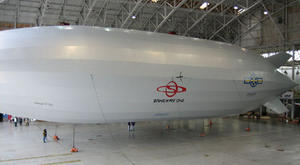BlimpsBorder Patrol decides not to purchase a balloon to aid communication among agents
An Arizona-based company makes a balloon that carries light-weight communication gear at 60,000 to 100,000 feet above the earth, and can extend the range of two-way radios on the ground as much as 40-fold; the Border Patrol showed interest in the balloon as a means to help its agents better communicate with each other and with law enforcement in remote border areas; but Border Patrol decided not the to pursue the balloon option

The Space Data communication blimp // Source: insightmedia.info
Nearly three years ago, at the request of DHS, an Arizona-based technology company conducted a demonstration of a communications balloon that could exponentially increase the ability of Border Patrol agents to monitor America’s southern border.
The balloon, made by Chandler, Arizona-based Space Data Corp., carries a lightweight communications payload 60,000 to 100,000 feet above the earth, and can extend the range of two-way radios on the ground as much as 40-fold. Small, easy to transport, and simple to deploy, Space Data’s balloons are far more cost-effective than comparable satellite technology, and they are already being used by the Air Force and Marines in Iraq and Afghanistan.
Along the Mexican border, the balloons could greatly improve monitoring and communications between border patrol and law enforcement officials on the ground, especially in the deep canyons and mountain ranges where illegal immigrants routinely travel.
Quenneville said the Border Patrol agents at the demonstration gave Space Data’s device an overwhelmingly positive response.
Fox News’s Katie Cobb reports that despite the positive response, nothing happened. Border Patrol, a division of DHS, did not pursue a contract with the company.
“We sort of sat by the phone wondering, ‘What’s the next step?’” Quenneville said. “In the end, we were left with nobody pushing to get that sort of capability. The Border Patrol said it didn’t have the specific requirement in its budget for a balloon-borne platform.”
Quenneville suspects the lack of follow-up had to do more with the fact that Space Data’s technology is very different from the tools currently being used by the Border Patrol. The company has contracts with the Air Force and Marines, as well as deals under consideration with the other branches of the military and several other countries.
Cobb notes that Space Data’s platforms also are used by a variety of industries for a range of applications, including pipeline monitoring, fleet vehicle tracking, remote data transmission, and emergency communications. After Hurricane Katrina devastated the Gulf Coast, the company testified before Congress on how its technology could be implemented in a disaster scenario.
For now, though, its technology will not be deployed to address what many say is a growing national security problem unfolding on the U.S. border with Mexico.
After nearly three years
